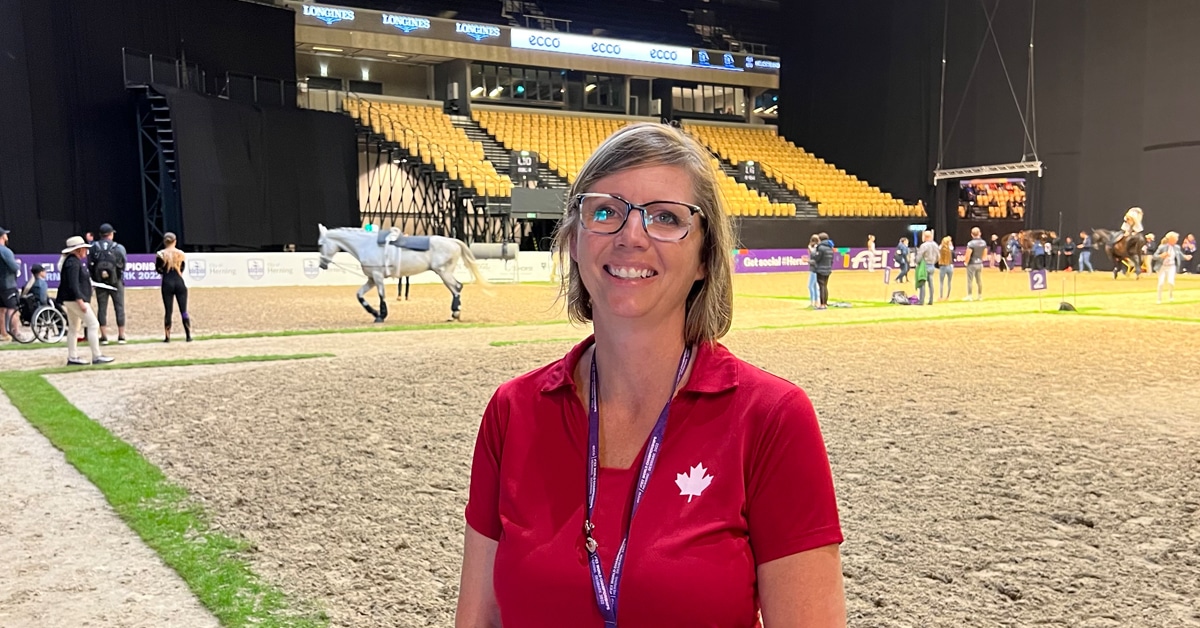Kathleen Saunders is the new vaulting chef d’équipe, and her years of international experience with the sport is what landed her the role.
“I’m there for support and as the communicator of information,” says Kathleen of what she does as chef d’équipe for Canada’s three vaulters at the Herning World Championships. “I’m the mid-person passing the information from the organization, from James [Hood], and delivering it to our athletes and the crew that is helping our athletes. I just make sure that everyone has the information in the back, make sure everything is going well in warm-up and answering any questions. Making sure everyone has their numbers on to compete, just the little things that sometimes get forgotten in the moment.”
Kathleen got her experience in vaulting as the mother of Canadian vaulter Averill Saunders. The two have travelled the world attending vaulting clinics and competitions, making friends and contacts along the way.
“The vaulting community is really cool,” enthuses Kathleen about the small group of international vaulters. “It’s a pretty amazing thing about vaulting. I feel we are connected with so many countries and people from around the world that really care and rally behind you.”
That supportive spirit has been a tremendous help to the small group of Canadians that don’t have the funds to own and transport their own horses around the world to compete. Instead, the team relies on leased horses from other countries.
Talmage Conrad and Shaina Hammond are both vaulting on William II Z, a German-owned horse who is also the reserve horse for the Spanish team. Averill is vaulting on Rockemotion, a reserve horse for the German team she secured just two months before the Championships when her originally scheduled horse didn’t work out.
“Luckily enough, we were able to have the opportunity to vault on such an amazing, highly-recognized horse,” commented Kathleen on their last-minute luck. “The training time was very short; she only had a few weeks to bond and connect, and it’s just been a beautiful relationship.”
Ideally, the vaulters would train and work with the same horse that they compete with, but they have become used to their reality and have learned to forge a bond quickly.
“It is really tough, but the kids are so well adapted,” explains Kathleen. “Sometimes you think maybe that’s not giving them the advantage they need but at the end of the day, all the Canadians are used to it, so when you hit these tight pinches they are really well adapted to making it work in the moment, which is a really great skill.”
The vaulters are also adept at quickly developing a relationship with the lunger, who is another important part of the vaulting equation.
“It’s not just a lunger, it’s a person you are connected to. You spend hours together, there’s a bond. They know your ups and downs. They watch you compete, they know the moment to back up, the moment to push,” adds Kathleen. “It’s a three-person team absolutely and we really try our best to do that in the time we have. The Canadians have done a wonderful job of connecting with the people and the horses they are with.”
The international experience is invaluable to the team that is slowly gaining more world recognition.
“The vaulters that you’ve just watched on YouTube videos and then all of a sudden you are seeing it for real and it is so different live. It’s an amazing feeling to be competing next to some of the top vaulters and seeing how they work, watch them warm up and see how different countries manoeuvre stuff.”
Kathleen will return home to Sundre, Alberta, on the 12th, but has really enjoyed her experience.
“It’s so beautiful here. The facility, the site, the coordinating colours, everything. It’s just got that wow factor. By far it’s my favourite venue, for sure.”

